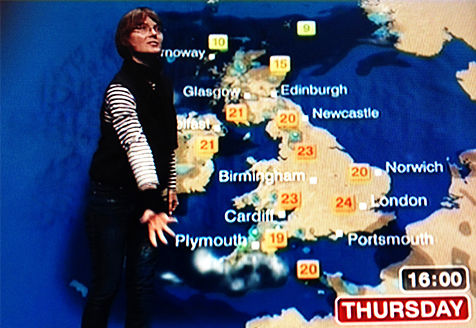
Erja Salo trying out The National Media Museum's Experience TV exhibition. (photo: Ilona Kolhonen) Mobius is a fellowship programme organised by the Finnish Institute in London and the Finnish Cultural Institute in New York that enables mobility for visual arts, museum and archives professionals. In the Institute’s new series of interviews the fellows compare the different circumstances and practices between their sending and receiving cities.
The Finnish Museum of Photography’s Head of Education and Public Programmes Erja Salo spent two months in The National Media Museum in Bradford.
I became interested in the Mobius programme as an opportunity to escape my routine: to take time for myself, to think about my own professional identity, job description, and everything I’ve been involved with in my own museum during the past 10 years. In a sense I went on exchange to see my own work in Finland more clearly. My expectations have been fulfilled, and I’ve also learned much. You learn a lot about yourself when you let go of your familiar social circles and practises and experience a new work community and culture.
I received a grant from the Akava Special Branches, part of the labour market central organisation Akava, in connection with the work exchange. It has allowed me to travel much more than usual. I’ve met and interviewed about 30 museum or gallery professionals from 13 different museums and galleries in England and Scotland. I’ve also met with regional actors in the field of culture. Knowledge of Finnish museums’ operational environment, cultural politics and museum statistics have been important in these meetings, and I feel I’ve represented, not just the knowhow of my own museum, but also the entire Finnish museum community.
Successful meetings resolted to my own museum gaining visibility and it has felt like some kind of partnerships could be viable in the future through for example EU funding. The public programming related to exhibitions or individual projects very rarely receive international visibility and partnerships through touring in the way that exhibitions do. It’s however completely possible to also tour public programming concepts, such as workshop models or other activities, alongside the exhibition.
The Finnish Museum of Photography is in Helsinki, and capitals are always a case of their own: one can’t say that museums in Helsinki represent museums in the whole of Finland. The operational environment, geography, and demographics matter. The National Museum of Media was founded in 1983 and is a member of four museum cluster that operates in London (Science Museum), Manchester (The Museum of Science and Industry), Bradford (The National Media Museum), and York (The National Railway Museum). The visitor research done by the cluster is very significant nationally. Each museum knows its visitors well and the research results guide the work done in the museum.
The National Media Museum is not only national but also local in nature. Reaching the local Yorkshire families and schools is a central part of their museum education programme, as is developing the Lates event, which is aimed at young adults, to a permanent event that attracts thousands of young people. The strategic objectives of the museum are tightly linked to the development projects of the city of Bradford, in which the museum is considered one of the central agencies in the region. The current significant cuts in public spending affect museums’ action plans and strategies both in England and Finland.
I haven’t encountered anything completely new or mind-blowing. The public programming in Finnish museums is of a high quality, but it’s not well-known because there are no materials available on it in English. International collaboration, project parterships and visibility require that at least a short description of the public programme and projects, in addition to plenty of pictures, are available on a museums’ English website. This is a shortcoming I want to work on in my own museum on my return.
The things I’ve learned the most about are strategic planning and management. Another essential souvenir to bring home with me is using different visitor or customer panels in public programming and in planning and evaluating the operations of the entire museum. Then I have a long list of things and practises that were already vague ideas in my mind before the work exchange, but the Mobius project has confirmed them and made developing and planning them possible. These are, among others, using the exhibition space as a place of activity and encounter, having artists participate in museum education, bringing audience outreach into the centre of operations, and slow museum thinking beside doing and action.
As the final lesson I will take home with me the attitude, in other words, the friendliness of British museums’ front-of-house staff. In each museum that I visited I got the immediate attention of the front-of-house staff already in the lobby with the words: ”Welcome, how can I help you?” It’s so simple that its significance might sometimes be forgotten, although ultimately it’s about the beginning of the visitor’s entire museum experience.
